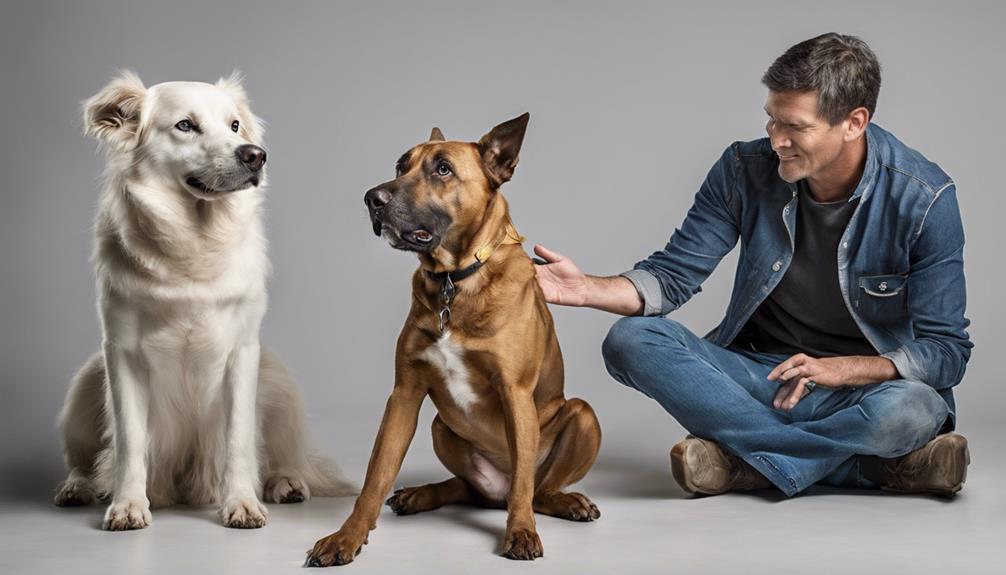Picture yourself as a beacon in the storm, leading your blind and deaf dog through the rough waters of anxiety. Don’t worry, there are ways to help alleviate their distress and bring peace to their world.
By implementing simple yet effective strategies, you can provide the support and security they need to navigate through their challenges with confidence and comfort.
Stay tuned to discover the ten essential ways to help your beloved companion cope with anxiety and thrive in their unique journey towards peace of mind.
Key Takeaways
- Create a safe environment by removing hazards and using barriers.
- Implement calming techniques like soft bedding and gentle massages.
- Establish predictable routines with regular feeding times and visual cues.
- Enhance home navigation with tactile markers, distinct textures, and scent trails.
Establishing a Safe Environment
To help your blind deaf dog cope with anxiety, begin by establishing a safe environment free of potential hazards and obstacles. Remove sharp objects, open flames, and any obstacles that could pose a danger. Use barriers and gates to block off areas like stairs, pools, and sharp corners to prevent accidents.
Keeping the living space clutter-free and organized can help minimize confusion and anxiety for your furry friend. Consistent layout of furniture is key to helping your dog navigate the home easily and reduce disorientation. By maintaining a consistent layout, you provide a sense of familiarity and security for your pet.
Regularly inspect and secure the environment to ensure it remains a safe and comfortable space for your blind deaf dog. Creating a safe haven for your pet is essential in easing their anxiety and helping them feel secure in their surroundings.
Implementing Calming Techniques

Creating a peaceful environment with familiar scents and sounds can be beneficial in reducing anxiety for your blind deaf dog. Here are some calming techniques to help your furry companion feel more at ease:
- Soft Bedding: Providing a comfortable and secure resting area with soft bedding can help alleviate stress in blind deaf dogs. This cozy spot can become their safe haven where they can relax and feel protected.
- Gentle Massages: Gentle massages and soothing touch can help calm anxious blind deaf dogs and strengthen the bond with their owners. This physical connection can provide reassurance and comfort to your pet.
- Calming Sounds: Using calming music or white noise machines can create a soothing atmosphere for blind deaf dogs to relax in. The gentle background noise can drown out sudden sounds that may startle them, creating a serene environment for your furry friend to unwind.
Providing Olfactory Enrichment

Stimulate your blind deaf dog's sense of smell through olfactory enrichment to promote mental stimulation and reduce anxiety. Introducing stimulating scents can engage your dog's olfactory senses, providing essential cognitive activity. Scent games and puzzle toys are excellent tools to make the enrichment process enjoyable. You can create scent trails or hide treats around the house to encourage exploration and mental engagement. Remember to rotate scents regularly to keep the activities exciting and prevent habituation.
Olfactory enrichment is a powerful tool to alleviate anxiety in blind deaf dogs. By tapping into their sense of smell, you offer a sensory outlet that can significantly improve their mental well-being. Engaging your dog's olfactory senses not only provides mental stimulation but also helps create a sense of security and comfort.
Embrace the opportunity to enrich your dog's environment with stimulating scents, promoting a happier and more relaxed state of mind for your beloved furry companion.
Creating Predictable Routines

Establishing consistent routines is key to helping your blind deaf dog feel secure and reduce anxiety. Here are some practical ways to incorporate predictable routines into your pet's daily life:
- Feeding Schedule: Set regular feeding times and locations for your blind deaf dog. Consistency in meal times can provide a sense of security and comfort, reducing anxiety levels.
- Daily Activities: Follow a predictable daily schedule for activities such as walks and playtime. Providing stability and structure in your dog's day can help them feel more at ease in their environment.
- Transitions and Cues: Use visual cues and tactile signals to communicate transitions and activities. Creating a structured environment with clear routines and cues can significantly contribute to calming anxiety in blind deaf dogs, as they rely heavily on these signals to navigate their world.
Enhancing Home Navigation

To help your blind deaf dog navigate your home more confidently, consider using tactile floor markers, scent trails, and strategic placement of auditory cues. These tools can provide valuable guidance for your furry companion, making it easier for them to move around safely and independently.
Tactile Floor Markers
Enhance your blind deaf dog's home navigation by incorporating tactile floor markers throughout key areas in your living space. These markers serve as physical cues, aiding your furry friend in moving around confidently. To create a more accessible environment for your dog, consider the following:
- Use Different Textures: Implement materials like carpet squares or textured tiles to distinguish various areas in your home.
- Place Markers Strategically: Position markers near important locations such as food bowls, bed, and doorways to assist in spatial orientation.
- Promote Consistency: By training your dog to recognize and follow these markers, you can help reduce anxiety levels and enhance their independence within the house.
Scent Trails for Guidance
Creating scent trails at home can greatly assist your blind deaf dog in navigating their surroundings with confidence. Utilizing the powerful sense of smell, you can strategically place scent cues near important areas like food bowls or bedding to help your furry companion orient themselves effectively.
These scent trails not only provide a sensory map for your dog to navigate familiar spaces but also reinforce their mental map of the environment with consistent scents for specific locations. By incorporating scent trails, you can help reduce anxiety and promote independence for your blind deaf dog, allowing them to move around the house with ease and comfort.
Trust in their ability to use their keen sense of smell to enhance their daily life.
Auditory Cues Placement
Placing auditory cues strategically around your home can significantly aid your blind deaf dog in navigating their surroundings with confidence.
- Consistent sound markers near important locations like food and water bowls can help with orientation.
- Position auditory cues at different heights to accommodate your dog's movement range.
- Use specific sounds or cues for different areas of the house to create a mental map for your dog.
Enhancing Yard Navigation

In your blind deaf dog's yard, establishing clear pathways and borders with scents or objects is crucial for aiding navigation and reducing anxiety. Using a combination of your dog's sense of touch and smell, you can create a safe and familiar environment for them to move around confidently. Consider incorporating textured surfaces or different ground coverings to indicate different areas in the yard. Installing barriers or fencing around potential hazards like pools, ponds, or sharp objects is essential to ensure your dog's safety.
To further assist your dog in navigating the yard, place distinctive markers or wind chimes at key locations to help them orient themselves. These auditory and tactile cues can provide important reference points. Additionally, a sensory garden with different plants and textures can engage your dog's senses and offer mental stimulation while they explore their surroundings.
| Ideas | Description | Benefits |
|---|---|---|
| Textured Surfaces | Use different textures on the ground to indicate different areas in the yard. | Helps your dog differentiate spaces. |
| Barriers | Install barriers or fencing around hazards to prevent accidents. | Enhances safety measures for your dog. |
| Distinctive Markers | Place markers or wind chimes at key locations to aid orientation. | Provides auditory and tactile guidance. |
| Sensory Garden | Create a sensory garden with diverse plants and textures for mental stimulation. | Engages your dog's senses positively. |
Reducing Stress Factors

To help reduce stress for your blind deaf dog, consider setting up a calming environment with familiar scents and textures.
Establishing a consistent routine can also provide a sense of security and stability for your furry friend.
Using positive reinforcement techniques like gentle touch and reassurance can further soothe anxiety in your blind deaf dog.
Calming Environment Setup
When creating a calming environment for your blind deaf dog, focus on reducing noise levels and incorporating soothing scents to aid relaxation.
Here are some practical steps to help set up a stress-free space for your furry companion:
- Minimize Noise: Keep the environment quiet by avoiding loud sounds or sudden noises that could startle your sensory-impaired dog.
- Soothing Scents: Use essential oils or pheromone diffusers to introduce calming scents that can help alleviate anxiety triggers and promote a sense of tranquility.
- Soft Lighting: Opt for gentle lighting or night lights to maintain a comforting ambiance, preventing disorientation and helping your blind deaf dog feel safe and secure in their surroundings.
Consistent Routine Establishment
Help your blind deaf dog feel more secure and at ease by establishing a consistent routine that reduces stress factors in their daily life. Blind deaf dogs benefit greatly from predictability and stability in their routines. Ensure regular feeding times, walking schedules, and playtime to create a sense of security and comfort.
Daily activities like meals and exercise sessions help normalize their environment and reduce anxiety. By sticking to a predictable routine, you can minimize unexpected changes that might trigger stress in your furry friend. Consistency in their daily activities not only promotes a sense of security but also helps them navigate their surroundings with confidence.
Embrace the power of routine to provide your blind deaf dog with a stable and reassuring environment.
Positive Reinforcement Techniques
Consider using a variety of high-value treats and rewards to positively reinforce desired behaviors in your blind deaf dog. Here are some positive reinforcement techniques to reduce stress factors:
- High-Value Treats: Utilize treats that your dog loves and responds to well, such as small bits of cooked chicken or cheese.
- Daily Routine: Establish a consistent daily schedule to provide your dog with a sense of security and predictability, which can help alleviate anxiety.
- Interactive Toys: Engage your dog's mind and prevent boredom by using interactive toys and puzzles that cater to their sense of touch and hearing.
Positive Touch Associations

To promote a sense of security and trust in your blind deaf dog, incorporate positive touch associations into your daily interactions with them. Blind deaf dogs rely heavily on touch to navigate the world, so gentle and consistent touch can help them feel secure and build trust with you. By creating positive touch experiences, you can calm anxious behaviors in your furry companion and enhance the bond you share.
Use touch cues to communicate affection, reassurance, and safety to your blind deaf dog. These cues can help reduce anxiety and promote a sense of comfort. Whether it's a soothing belly rub or a reassuring pat on the head, positive touch associations play a crucial role in helping your dog cope with anxiety. Remember, your touch is a powerful tool in providing your pet with the love and security they need to feel at ease.
Training for Anxiety Management

When training your blind deaf dog for anxiety management, focus on using behavioral reinforcement techniques to help reduce fear responses.
Incorporating calming exercises and tools into your training routine can provide comfort and support for your furry friend.
Remember to utilize positive reinforcement strategies to help your dog associate anxiety triggers with positive experiences.
Behavioral Reinforcement Techniques
To help your blind deaf dog cope with anxiety, implement positive reinforcement training techniques that focus on rewarding calm behaviors and building confidence in their environment.
Here are some strategies to consider:
- Use Treats, Praise, and Rewards: Offer your dog treats and praise when they exhibit calm behaviors, such as sitting quietly or responding well to cues. This positive reinforcement helps associate good behavior with positive outcomes.
- Consistent Training Sessions: Regular training sessions provide structure and predictability for your dog, helping them feel more secure and confident in their surroundings.
- Avoid Punishment: Steer clear of punishment-based methods as they can escalate anxiety in blind deaf dogs. Seek guidance from a professional animal behaviorist for tailored strategies to manage your dog's anxiety effectively.
Calming Exercises and Tools
Consider incorporating calming exercises and tools into your blind deaf dog's routine to help effectively manage their anxiety. Deep pressure therapy can be soothing for your dog, reducing anxiety levels. Engage their minds with interactive toys and puzzles to distract from anxious behaviors. Aromatherapy using calming scents like lavender can create a serene environment. Provide a safe space or den where your dog can feel secure when anxious. Tools such as thunder shirts or weighted blankets can offer comfort and a sense of security. Below is a table to help you understand how these calming exercises and tools can benefit your beloved companion:
| Calming Exercise/Tool | Description | Benefits |
|---|---|---|
| Deep Pressure Therapy | Gentle pressure applied to calm your dog | Reduces anxiety levels |
| Interactive Toys | Toys that engage your dog's mind | Distracts from anxious behaviors |
| Aromatherapy | Calming scents like lavender for relaxation | Creates a soothing environment |
| Safe Space/Den | Designated secure area for your dog | Offers a sense of security |
Positive Reinforcement Strategies
To assist your blind deaf dog in managing anxiety, focus on utilizing positive reinforcement strategies through targeted training methods. Positive reinforcement training can play a crucial role in reducing anxiety triggers and promoting calm behavior in blind deaf dogs. Here's how you can implement these strategies effectively:
- Reward Calm Behavior: Use treats, praise, and toys to reward moments of calmness and relaxation.
- Consistent Training Sessions: Regular training sessions focusing on positive reinforcement techniques can help build confidence and trust.
- Desired Behaviors: Reward desired behaviors like staying calm and relaxed to help your blind deaf dog cope with anxiety effectively.
Seeking Professional Support

Seek professional support for your blind deaf dog by consulting with certified animal behaviorists or veterinarians specializing in sensory-impaired pets. These professionals can offer tailored strategies and training techniques to address your dog's anxiety issues effectively. By seeking guidance from experts, you can create personalized plans that cater to your blind deaf dog's specific needs, ultimately improving their overall well-being.
Veterinarians experienced in sensory loss can provide essential medical evaluations and recommend suitable supplements or medications to alleviate anxiety in blind deaf dogs. Collaborating with these professionals won't only enhance your understanding of your dog's needs but also ensure a holistic approach to managing their anxiety.
Frequently Asked Questions
How Do You Comfort a Blind and Deaf Dog?
You comfort a blind and deaf dog by using gentle touch, familiar scents, and a consistent routine. Create a safe environment with minimal changes, offer calming aids like pheromone diffusers, and provide love, patience, and understanding to alleviate anxiety.
How Do You Make a Blind and Deaf Dog Happy?
To make your blind and deaf dog happy, focus on creating a comforting environment with familiar scents and textures. Establish a routine, engage them with interactive toys, and show them lots of love and patience.
How Do You Calm an Anxious Blind Dog?
To calm an anxious blind dog, create a safe haven, stick to a routine, offer gentle touch, and consider calming aids. Consistency and comfort go a long way in soothing their anxiety. Remember, your presence and reassurance mean everything to them.
How Do You Calm an Anxious Deaf Dog?
To calm an anxious deaf dog, create a soothing environment with familiar scents and textures. Offer gentle touch and positive reinforcement. Stick to a consistent routine, engage in low-stress activities, and seek guidance from a vet or behaviorist for tailored strategies.
Can These Techniques to Stop Barking Help My Blind Deaf Dog Cope with Anxiety?
Yes, stopping your deaf dog’s barking can help alleviate anxiety. Using vibration collars or touch cues can redirect their attention. Providing a safe space and routine can also help ease their anxiety. Seek guidance from a professional trainer experienced with special needs dogs for additional support.
Conclusion
As you continue to support your blind deaf dog through their anxiety, remember that your love and dedication make a world of difference.
Picture your furry friend feeling safe, secure, and at peace in their environment thanks to your care.
Keep implementing these strategies, and together, you can create a calming sanctuary for your beloved companion to thrive in.
Your efforts truly make a heartfelt impact on their well-being.











